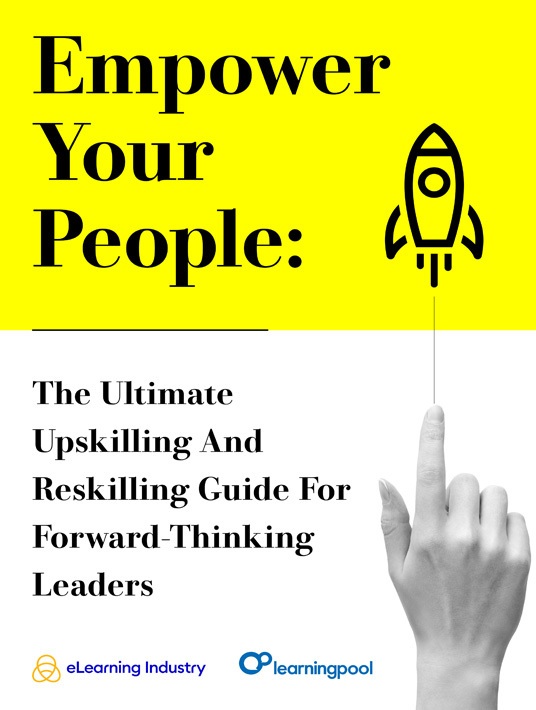The Impact Of Advanced Analytics In L&D
Data-driven decision-making is revolutionizing modern business. It's all about using facts rather than guesswork to make business-related choices. When it comes to your organization's L&D strategy, traditional approaches can only take you so far. So why not leverage data that allows you to understand your employees' learning patterns, strengths, and weaknesses? Advanced analytics in L&D can do exactly that; it takes all the data and makes meaningful insights out of it to help you drive better learning outcomes. Let's delve deeper into the world of intelligent data and robust reporting and show you how to implement advanced analytics in your L&D strategy.

The Power Of Intelligent Data In L&D
As a leader, you want your employees to be their best selves, constantly improving their skills and knowledge. But how do you know what areas need improvement? How can you tailor training programs to meet their needs effectively? That's where data-driven L&D strategies come in. By leveraging intelligent data, you gain invaluable insights into the learning behaviors and preferences of your employees. You can track their participation rates, evaluate their completion and dropout rates, and even check how much time they spend on modules. Therefore, all this information guides your decisions.
By leveraging data, you can create personalized learning content, providing employees with precisely the training they need to ace their roles. They will feel more motivated to perform better and learn continuously. Moreover, you can also see how employees' behaviors change after training in order to evaluate whether the L&D program was successful. This will allow you to make the necessary changes and adjustments.
Examples Of Intelligent Data To Consider
Learning Engagement Metrics
Learning engagement metrics allow you to measure the effectiveness of your L&D initiatives and identify areas for improvement. There are many metrics to consider, like employee participation rates, which show you how interested and involved your employees are in the learning activities. By tracking this, you can see which courses are attracting the most attention and which need some tweaking. You can also measure completion and dropout rates to see how many employees finish their courses and how many abandon them. This will also allow you to identify pain points and improve the learning experience.
Performance And Behavior Analytics
Performance and behavior analytics can indicate if all the efforts and resources you've put into training your employees have had a real impact on their job performance. By carefully analyzing the data, you can make a connection between the learning outcomes of your employees and their performance. This way, you can see which training programs are hitting the bullseye, making your workforce more productive. Moreover, this intelligent data allows you to track if your staffers are applying the knowledge they gained from the L&D programs. So, you can also assess the long-term impact of your training initiatives.
Feedback And Surveys
With advanced analytics, you can gather valuable insights directly from your employees. Consider creating surveys that'll be delivered to them after they've completed their training, asking them about the content and relevance of the L&D program. This will give you an idea of what's working or not while also empowering your employees and making them feel that their voices are heard. Loading the survey results into an analytics tool will help you evaluate satisfaction rates and make informed decisions regarding the program.
What Are The Dangers Of Ignoring Advanced Analytics?
It's risky to make decisions that aren't based on solid facts. But not every organization is positive about adopting advanced analytics methods, especially at first. As a leader, you may face reluctance since your workforce may feel comfortable with their traditional decision-making ways. However, neglecting intelligent data can lead to uninformed decisions and a waste of resources, which will jeopardize all your L&D efforts. By overlooking important information in the data, you risk losing opportunities for continuous improvement. Most importantly, though, it can put your company at a disadvantage in the competition. Organizations with data-driven decisions gain a competitive edge by staying agile and updated on market changes, thus sailing toward success.
How To Implement Advanced Analytics In Your L&D Strategy
Identify Data Sources
Nowadays, data is everywhere. From Learning Management Systems (LMSs) to performance evaluations, you can have access to a vast amount of data that's ready to be leveraged. Yet, the tricky part is identifying the sources that are most relevant to your organization's L&D goals. You can start with your existing systems. For instance, are you currently collecting any data from your LMSs or other databases? Can your HR department help by providing information? You shouldn't stop there, though. Seek data elsewhere, like social media, customer surveys, and other touchpoints. Don't forget to check out automated data collection, too, to reduce the chances of errors.
Choose Appropriate Analytics Tools
Before choosing an analytics tool or platform, you should consider your organization's needs and requirements. For example, what data do you want to collect and analyze? Are you looking to track learner engagement or evaluate your training program's effectiveness? Learning Management Systems are pretty popular and have built-in analytics capabilities. However, there are also more advanced options, like Business Intelligence tools, which can offer you personalized analyses and visualizations. Similarly, check out predictive analytics platforms that use Machine Learning to predict learning outcomes based on data.
Data-Driven Company Culture
A data-driven company culture isn't just about being comfortable using data; it's more about adopting data-driven decisions at all levels of the organization. As a leader, you need to set an example and show you're committed to data. Encourage open discussions about the matter and highlight that your decisions are data-driven. Don't hesitate to communicate every part of the process and share case studies and success stories with your staffers. When your entire company embraces data for making choices, you'll notice efficiency rising and your business heading for success.
Overcoming Data-Related Challenges
Privacy And Security
Data breaches are a real nightmare for any organization, and it's important to address privacy and security issues right from the start. All the data you collect contains sensitive information about your employees, so you need to safeguard it. Start by complying with the regulations or privacy laws in your area, like GDPR. Then, you need to set access controls since not everyone in the company needs to deal with data. This minimizes the risk of data leaks and unauthorized access. Also, don't forget to encrypt your data so that hackers can't use it, and regularly back it up to avoid data loss.
Integration
If you're not aware of the term "data silos," it's basically data stored in separate systems that aren't integrated, like scattered information across your company. This is problematic because if some departments aren't aware of specific data, they might do double work and lose opportunities. The key here is integration. You should bring all your data together in a single place where it can be shared with different teams so that everyone has the whole picture. You can consult your IT team or other professionals to help you unify different software and platforms. If it comes down to investing in new software, do it with no second thought, as it will save you resources and effort in the long run.
Data Literacy Of L&D Professionals
Many L&D professionals struggle to interpret and make use of data effectively, so they lack data literacy. Data can surely be overwhelming, but training your L&D team about it can help them navigate this landscape and learn how to read, analyze, and organize data, even in large sets. A data literacy training program will help L&D professionals recognize relevant information about each L&D strategy and create programs that align with the desired learning outcomes. They'll be able to avoid misinterpretations and better present results with striking visuals, creating optimal strategies for training programs.
Conclusion
Information is power, and the right data can be the key to unlocking your organization's full potential. With intelligent data, you have the opportunity to personalize and optimize your L&D strategy while offering your employees the best learning experience possible. Although adopting advanced analytics comes with some challenges, there's nothing you can't overcome with preparation and appropriate training. So, embrace modern technology and see the positive change in how your company learns and grows.
Download Empower Your People: The Ultimate Upskilling And Reskilling Guide For Forward-Thinking Leaders today to attract, retain, and fully engage top talent.

